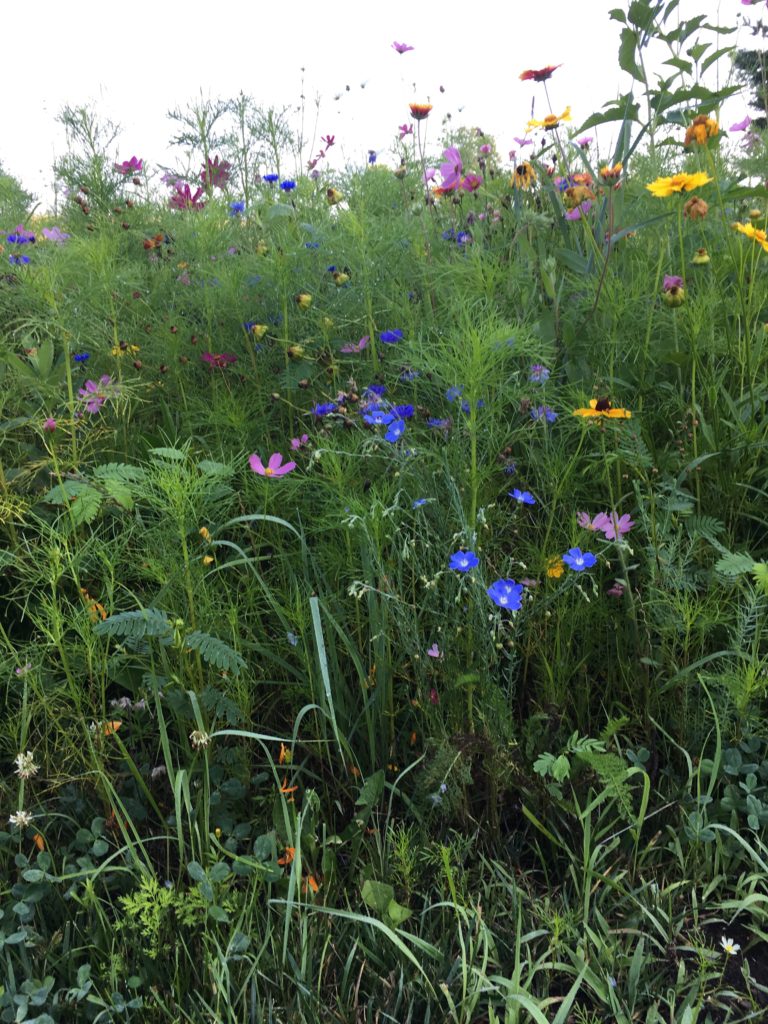July: Joy
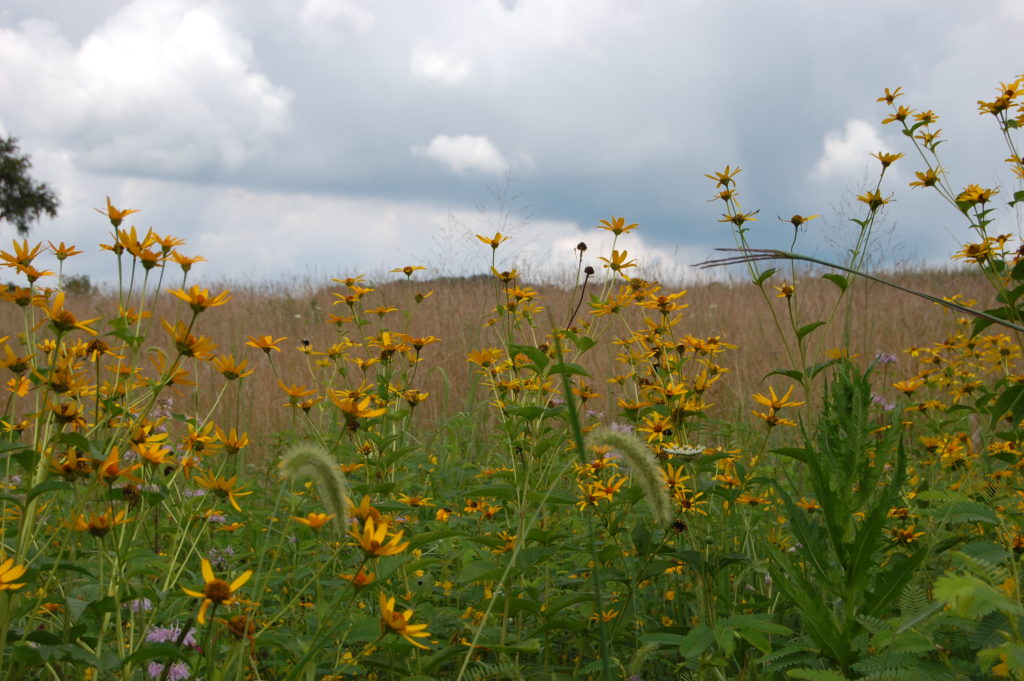 One morning, just after dawn, I stood on the easternmost path next to the Old Construction Road and was distracted by what sounded like a motor. Upon closer listening and inspection I realized it was hundreds of bees on the flowers. It was a bit alarming at first but they had no interest in me. One-by-one they zoomed off to the east flying right past me, with replacements arriving just as quickly. It was mesmerizing to watch. I went back during the noon heat and all was quiet. I guess they
One morning, just after dawn, I stood on the easternmost path next to the Old Construction Road and was distracted by what sounded like a motor. Upon closer listening and inspection I realized it was hundreds of bees on the flowers. It was a bit alarming at first but they had no interest in me. One-by-one they zoomed off to the east flying right past me, with replacements arriving just as quickly. It was mesmerizing to watch. I went back during the noon heat and all was quiet. I guess they
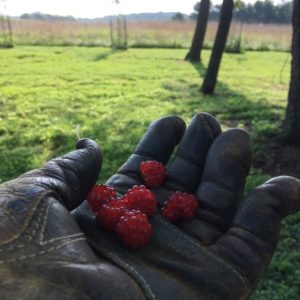
all went 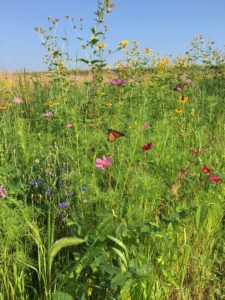 home to nap and stay cool.
home to nap and stay cool.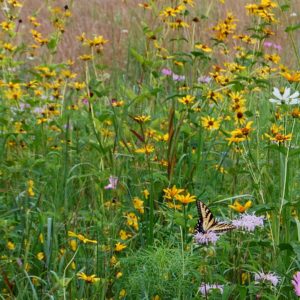
All sorts of other pollinators were busy in other parts of the meadow, drinking from the flowers and finding nesting places. These included: butterflies, moths, wasps, many species of bee, flies, gnats, lighting bugs and other beetles, and ants. The butterflies and moths are not so particular about the flowers that they visit but they are quite particular about where they lay their eggs. Host plants, like Milkweed for Monarchs, provide the correct nutrients and protections for the larval or caterpillar stage and each species seems to have its own specific plant or plants that it favors. This has 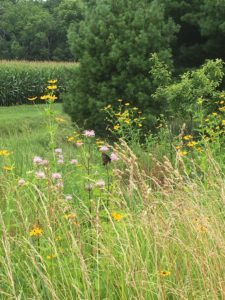 implications for the garden. If you want:
implications for the garden. If you want:
- Monarchs, plant Milkweed varieties
- Eastern Tiger Swallowtail, plant trees including fruits, Ash, Birch, and Tulip.
- Eastern Black Swallowtail, plant parsley varieties including the parsley you use in the kitchen and Queen Anne’s Lace.
- bLittle Yellow Moth, plant Senna or Partridge Pea
- Common Buckeye, plant just about any Plantain or Verbena
Check this site for a more complete listing of butterflies and moths and their host plants.
At the edges, the Meadow is full of fruits and flowers – I have not built up the courage to eat the Jack-in-the-Pulpit berries and leave then for the little creatures, but I do try to beat the hungry deer and rabbits to the Raspberries – I figure that there are many more berries in the impenetrable forest for them. This year I had planned to make raspberry jam but somehow they never made it out of the Meadow.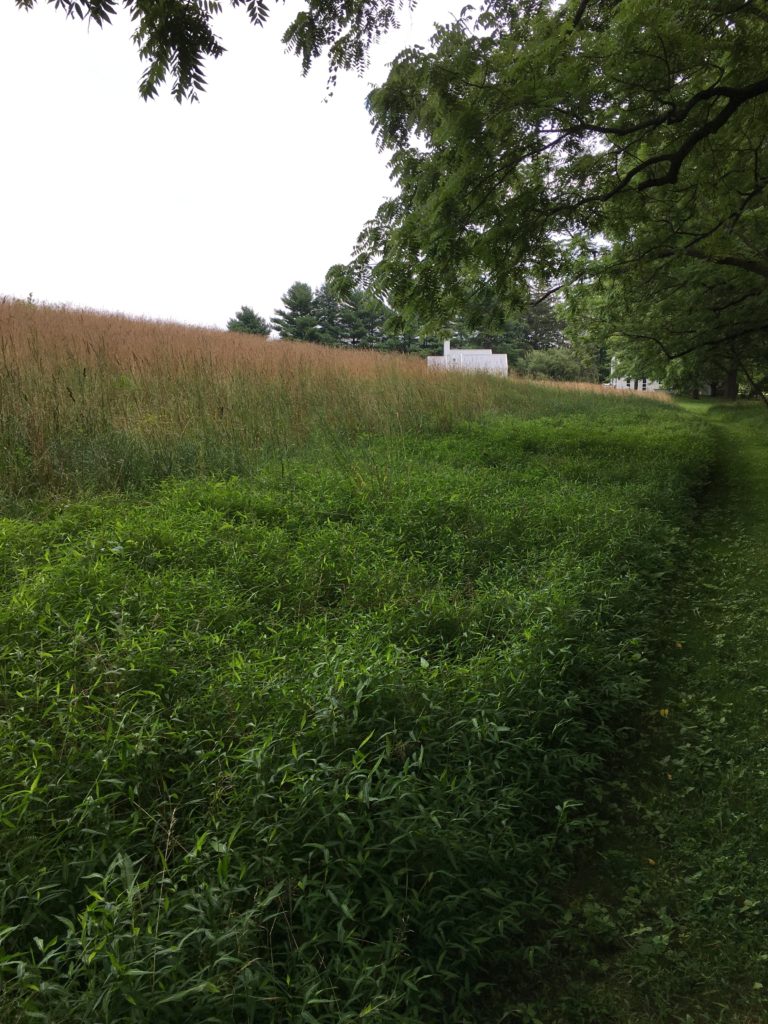
A ridge line along the lower part of the meadow marks the limits of the flood plain. Unless you trip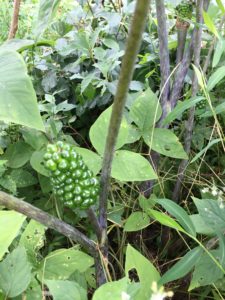 over it, the line is not usually noticeable but as the grasses grow it is easier to see the abrupt ecosystem change: plant species change, fleshier and darker green, lower growing. Interestingly I have only twice seen the stream cover this area
over it, the line is not usually noticeable but as the grasses grow it is easier to see the abrupt ecosystem change: plant species change, fleshier and darker green, lower growing. Interestingly I have only twice seen the stream cover this area 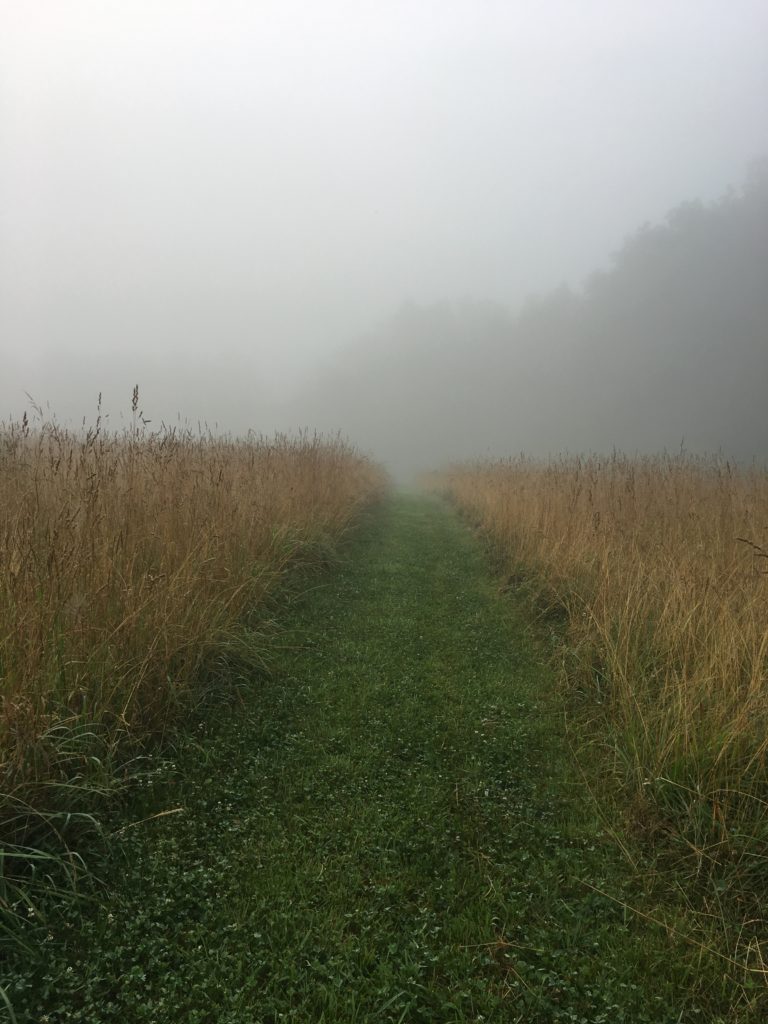 but the moisture persists.
but the moisture persists.
July joy comes from many corners – beautiful sunrises, warm, scented breezes, birds soaring, and misty mornings that bring a sense of mystery to the landscape. Often the mist forms a cloud that reduces visibility. This makes sounds become more important – little rustlings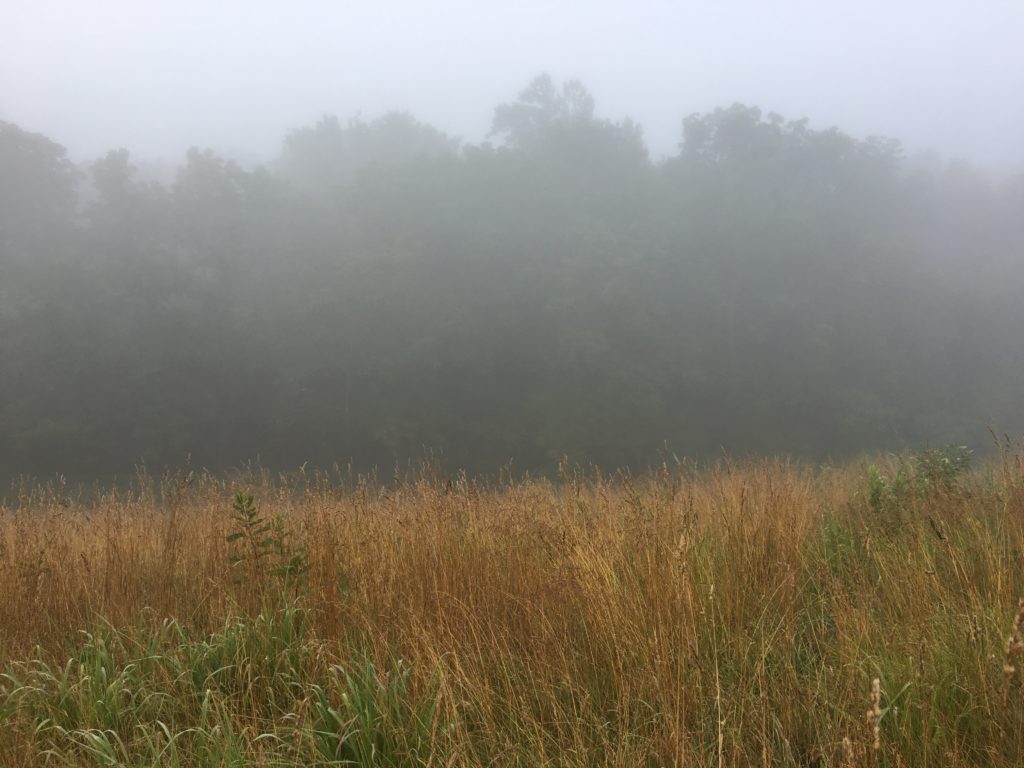 in the grass, a far-off bark, a horse’s neigh, the quite creaking of heron wings, the silence of the forest – the sounds are simultaneously spookily disconcerting and fascinating.
in the grass, a far-off bark, a horse’s neigh, the quite creaking of heron wings, the silence of the forest – the sounds are simultaneously spookily disconcerting and fascinating.
Yellows, oranges, pinks and green abounded in the fields but blue appeared only shyly in the form of Wild Blue Flax (Linum lewisii). Over time this 18-20” perennial should persist in the border and spread via seeds to add a sprinkling, mid-level surprise of color amongst the grasses and other flowering plants. Here it is among Coreopsis, Sunflower, Cosmos and Black-Eyed Susan.
In the early morning the Meadow is cool and silent, the colors are soft, and the dew clings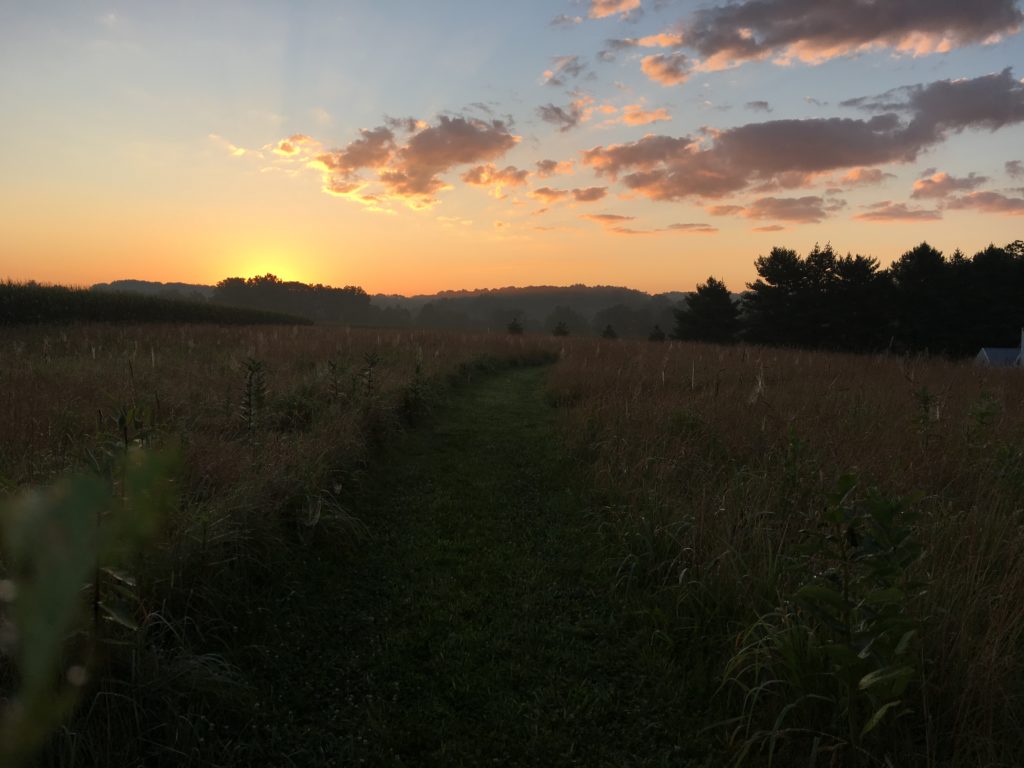 to everything – flowers, webs, me – thank goodness for Wellingtons! At dawn, the light catches on the dew and brings the mundane to life.
to everything – flowers, webs, me – thank goodness for Wellingtons! At dawn, the light catches on the dew and brings the mundane to life.
The grasses are at full height and more flowers come every day. The close-in flower border bursts with hundreds of Cosmos, Coreopsis, Bee Balm, Native Sunflower, Partridge Pea, Black-Eyed Susan’s and others, all vying for the attention of the numerous bees, wasps, moths and butterflies. In the front border of the Old Construction Road there is little sign of the compaction that was evident at the beginning of the season, but just behind the colorful front, grasses and flowers alike struggle to grow tall. The Native Sunflower is successful and will, with the Delphinium, likely be instrumental in breaking open the soil for other plants.
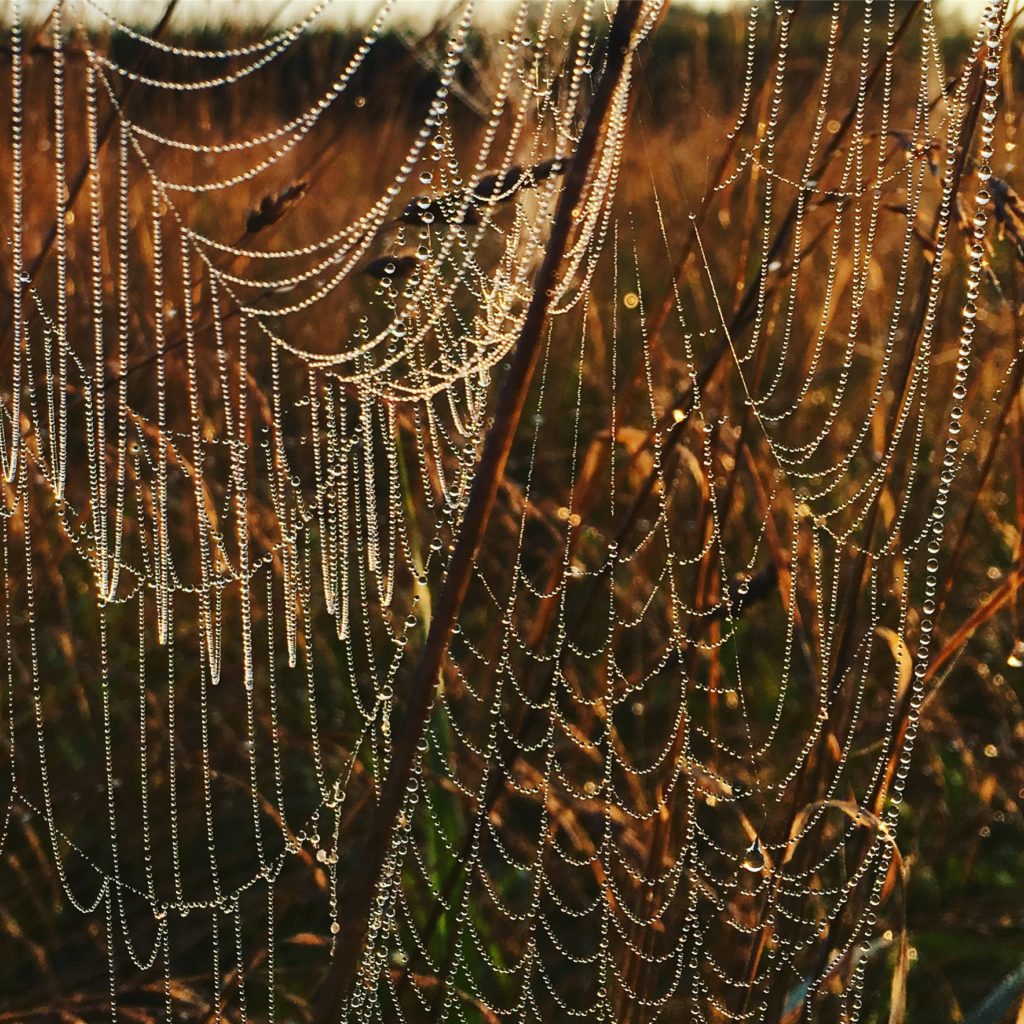
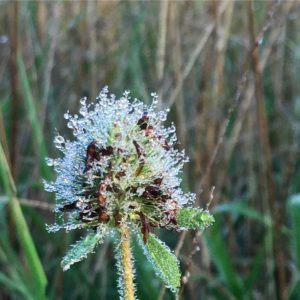
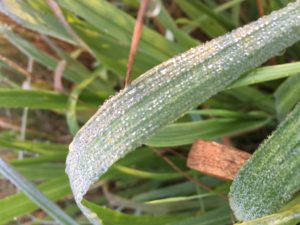
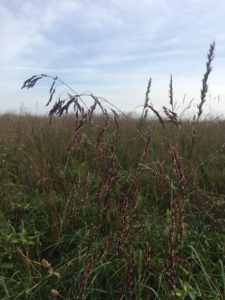 The meadow is not irrigated and the only plants that are watered are the new trees (which will continue to be watered through Year 3) and those in the containers near the houses – everything else has to fend for itself. The monthly average temperature for August was 85 degrees during the day and 61 at night – that cooling, together with the 4” of rain the garden received during the month, kept the meadow blooming happily.
The meadow is not irrigated and the only plants that are watered are the new trees (which will continue to be watered through Year 3) and those in the containers near the houses – everything else has to fend for itself. The monthly average temperature for August was 85 degrees during the day and 61 at night – that cooling, together with the 4” of rain the garden received during the month, kept the meadow blooming happily.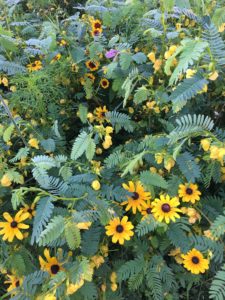
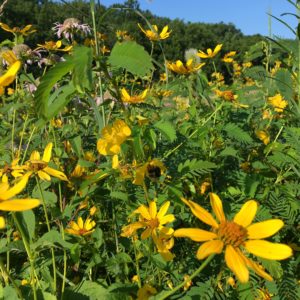
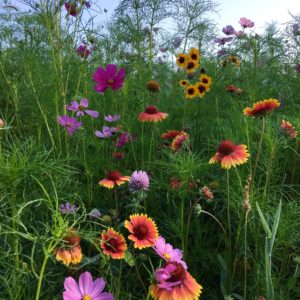
Not all the plants looked fabulous though – not for lack of care or need of water – but because of butterflies. Monarch caterpillars grow very quickly and eat almost non-stop from the time they hatch from their pin-drop sized egg to the time they form their chrysalis. From field observation it appears that, during this period of growth, one Monarch caterpillar will eat all the leaves off of two healthy Milkweed plants leaving behind very bare, bedraggled looking stalks. Milkweed is a survivor though. It grows 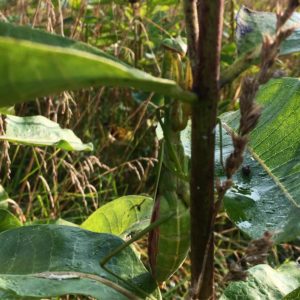
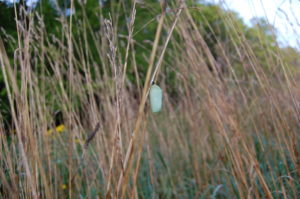
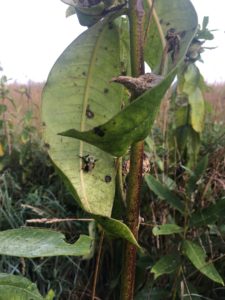 from thick underground roots and from wind distributed seeds and it grows new plants throughout the season. At one point you may have a brand-new sprout growing alongside a decimated stalk and a mature plant that is just beginning to bloom. Other creatures lurk on the decimated plants including napping bees and Praying Mantises on the hunt.
from thick underground roots and from wind distributed seeds and it grows new plants throughout the season. At one point you may have a brand-new sprout growing alongside a decimated stalk and a mature plant that is just beginning to bloom. Other creatures lurk on the decimated plants including napping bees and Praying Mantises on the hunt.
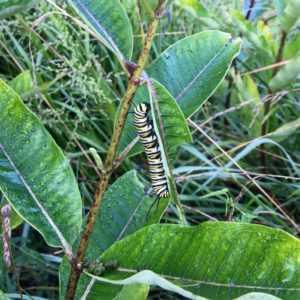 Almost unnoticed amongst all the flower drama, the fall blooming plants start to grow tall.
Almost unnoticed amongst all the flower drama, the fall blooming plants start to grow tall.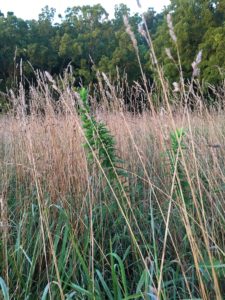 This is especially true of Common Goldenrod (Solidago canadensis and Solidago rugosa are in the meadow) and Big Bluestem grass (Andropogon garardii). Big Bluestem has been there all season showing off its three-part flower that give it the nickname Turkey Foot but it blooms and releases its pink seeds in late summer/ early fall.
This is especially true of Common Goldenrod (Solidago canadensis and Solidago rugosa are in the meadow) and Big Bluestem grass (Andropogon garardii). Big Bluestem has been there all season showing off its three-part flower that give it the nickname Turkey Foot but it blooms and releases its pink seeds in late summer/ early fall.
September: Late summer colors
The green of the foliage becomes more muted in September. Although the meadow is still going strong, the lively spring green has been replaced with a more mature, deeper green. The average daytime temperatures remain high but the evening temperatures start to dip into the low 50’s resulting in more misty mornings. The cooler evenings also begin to awaken the cool season grasses from their summer dormancy. The Redtop grass creates a haze of red over the meadow as it races to bloom.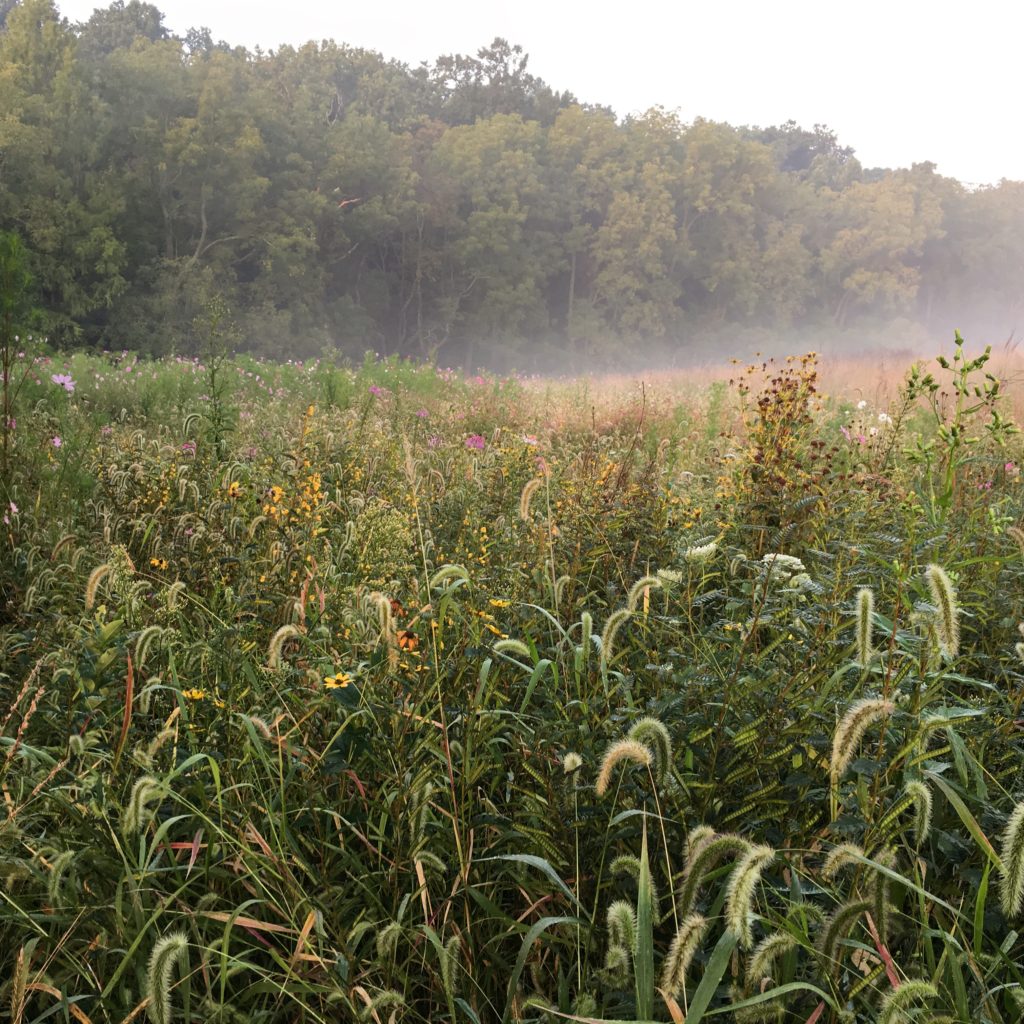
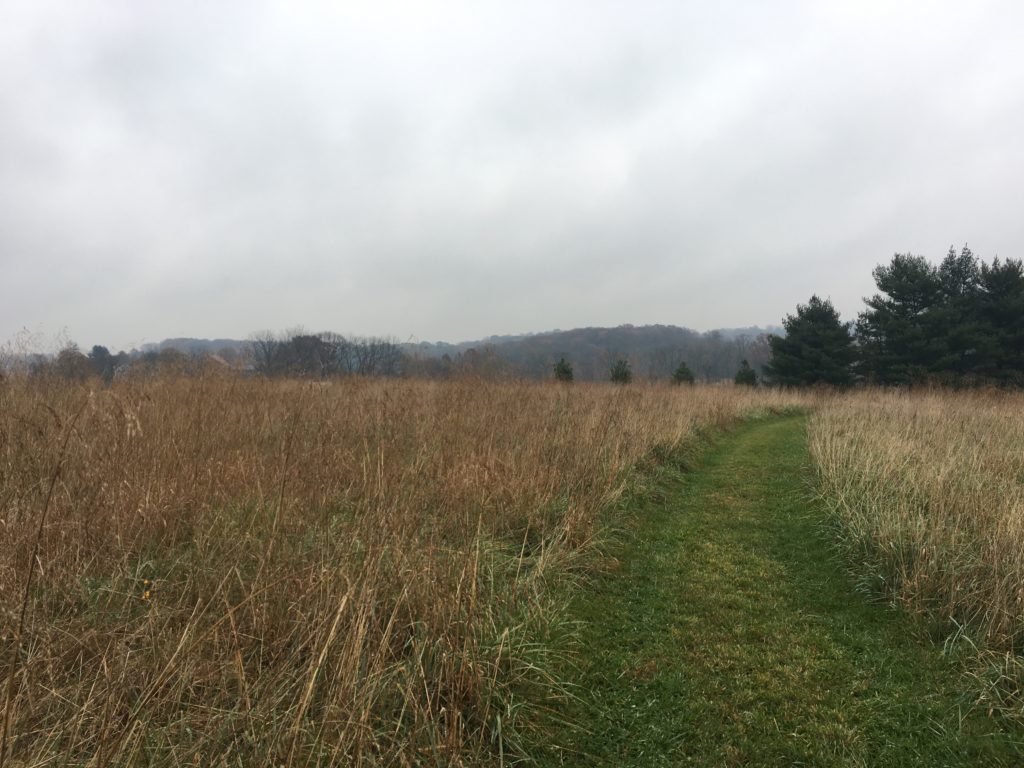 Most of the grasses that were part of the meadow’s existing seed bank are cool season grasses. This means that they are dormant in June, July and August and that they grow and bloom in the shoulder seasons. Part of the spring seeding program is designed to encourage a mix of cool and warm season grasses. Big Bluestem (Andropogon gerardii), Little Bluestem (Andropogon scoparius), Indiangrass (Sorghatrum nutans), and Switchgrass (Panicum virgatum) are all warm season grasses that have been overseeded across the entire meadow.
Most of the grasses that were part of the meadow’s existing seed bank are cool season grasses. This means that they are dormant in June, July and August and that they grow and bloom in the shoulder seasons. Part of the spring seeding program is designed to encourage a mix of cool and warm season grasses. Big Bluestem (Andropogon gerardii), Little Bluestem (Andropogon scoparius), Indiangrass (Sorghatrum nutans), and Switchgrass (Panicum virgatum) are all warm season grasses that have been overseeded across the entire meadow.
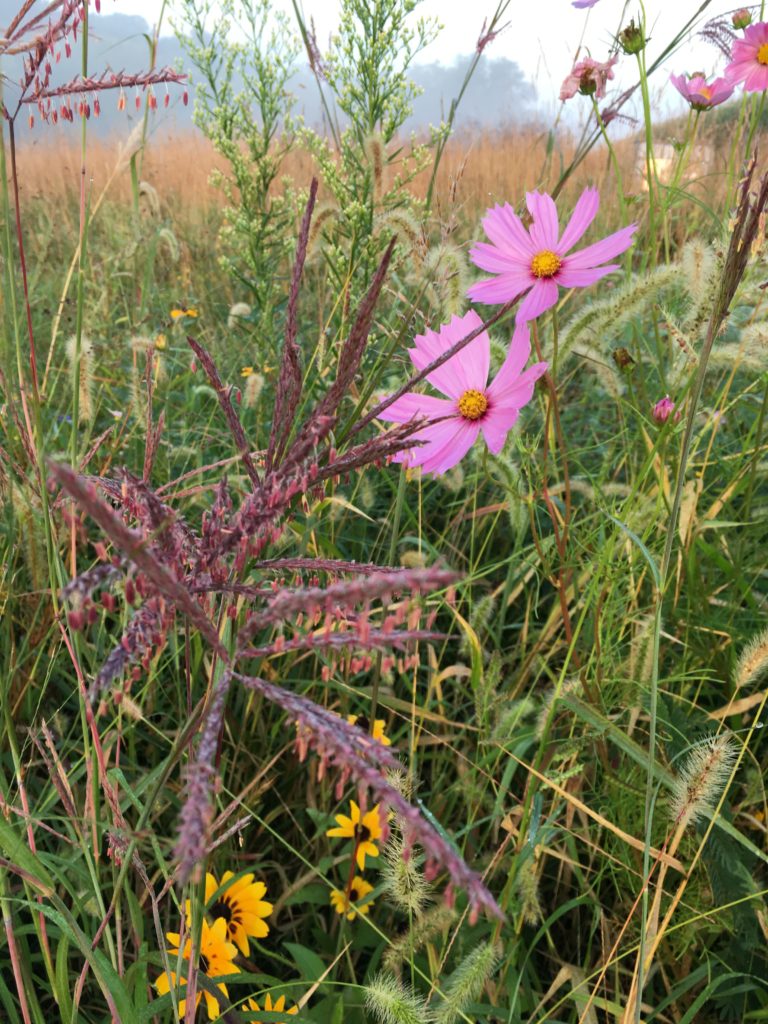 All of them are establishing themselves well but they seem to prefer the compacted, neglected soil of the Old Construction Road. This is very important as the deep roots that they develop will work to decompact and hold this soil. The stems, especially of the Big Bluestem are rigid and persist through winter, providing shelter to wildlife, and seem to be a favorite for Praying Mantis to construct their egg cases, and the seed
All of them are establishing themselves well but they seem to prefer the compacted, neglected soil of the Old Construction Road. This is very important as the deep roots that they develop will work to decompact and hold this soil. The stems, especially of the Big Bluestem are rigid and persist through winter, providing shelter to wildlife, and seem to be a favorite for Praying Mantis to construct their egg cases, and the seed 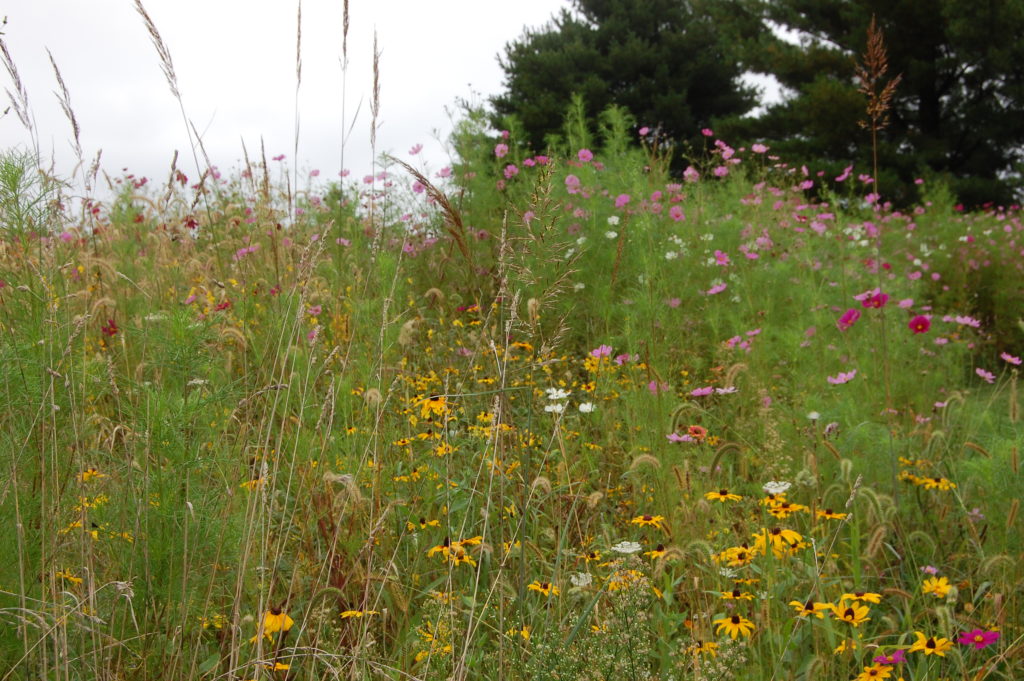 heads provide food for birds. These seed heads are also quite decorative. The bluestems have a blue-green leaf color that helps to wend the color blue throughout the field. The Big Bluestem flower is a beautiful pink-red that competes for attention with the
heads provide food for birds. These seed heads are also quite decorative. The bluestems have a blue-green leaf color that helps to wend the color blue throughout the field. The Big Bluestem flower is a beautiful pink-red that competes for attention with the 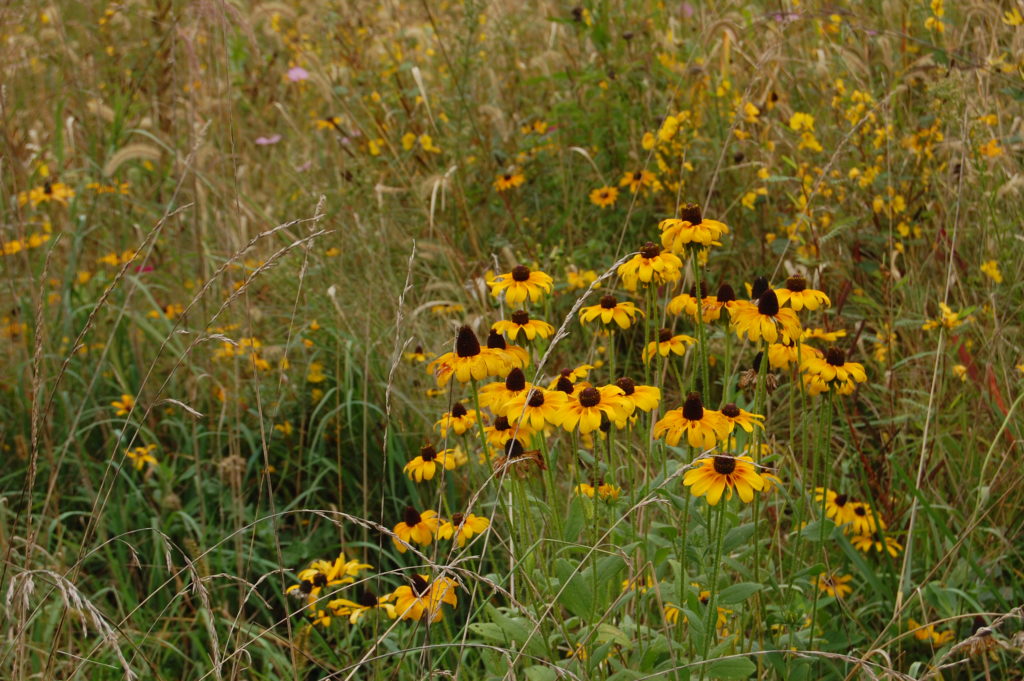 bright pink of the Cosmos.
bright pink of the Cosmos.
I always find it interesting when annuals and perennials are mixed. If seeded in 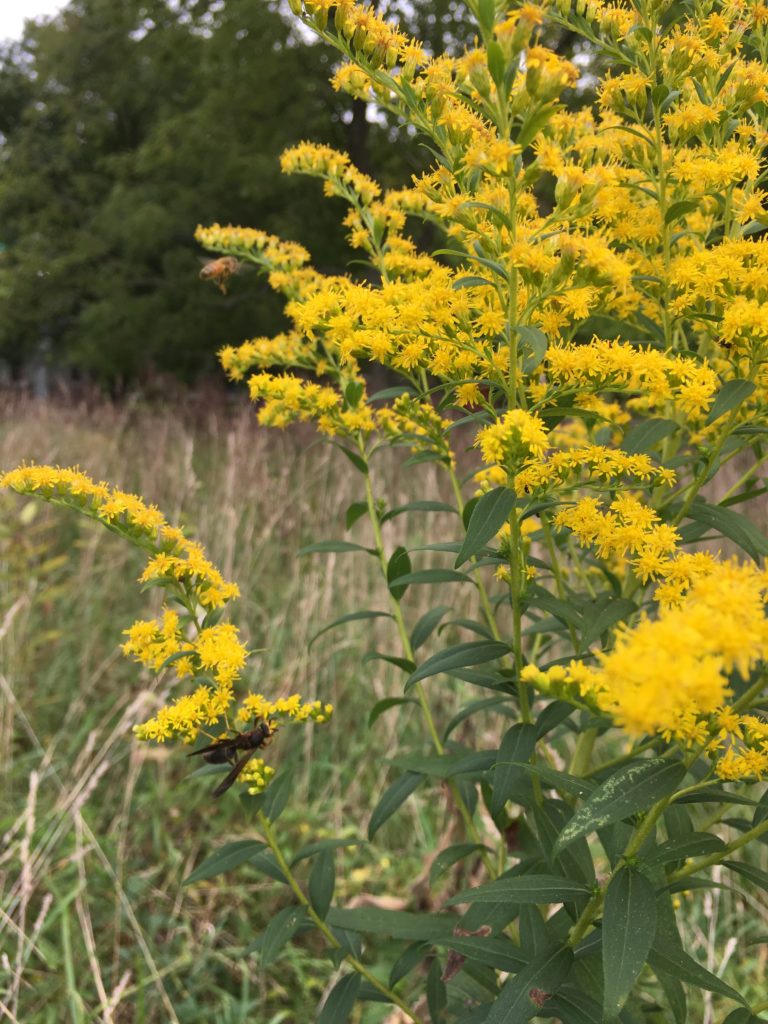 succession over the planting season (every other week or so), the annuals (in this case Cosmos) persist with the same basic show – beautiful but consistent – while the perennials bloom in a seasonal succession that is colorful but highly variable.
succession over the planting season (every other week or so), the annuals (in this case Cosmos) persist with the same basic show – beautiful but consistent – while the perennials bloom in a seasonal succession that is colorful but highly variable.
September is a time for an increased show of Black-Eyed Susan, an explosion of Goldenrod, and a beautiful display of purple-blue New England Asters.
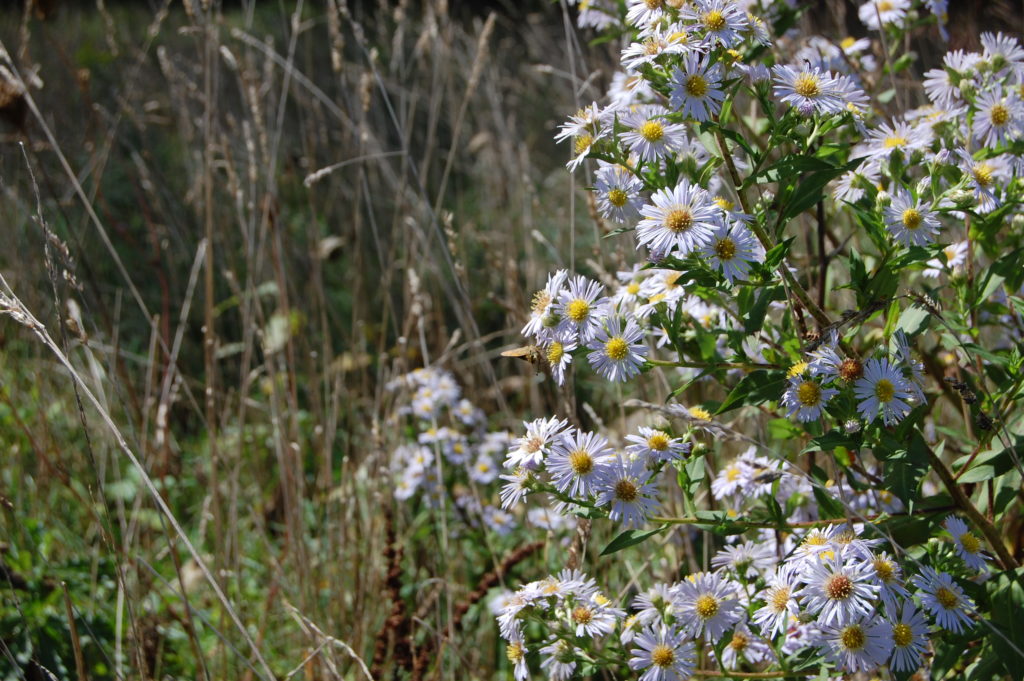 The Blue Mist flower finally bloomed late in the month giving hope that the rest of the gazillion seeds I distributed along the paths will be happily established next year.
The Blue Mist flower finally bloomed late in the month giving hope that the rest of the gazillion seeds I distributed along the paths will be happily established next year.
In contrast to the muted upper meadow, the Jack-in-the-Pulpit down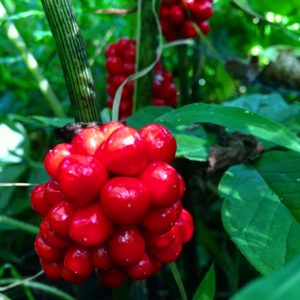
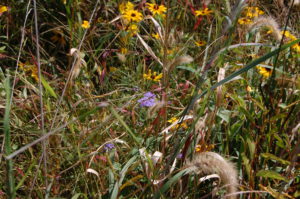 in the flood plain chose holiday reds and greens to attract small creatures, birds or small mammals to eat their berries and then disperse them about the fields in their guano. Quite a bright display in the quiet shade by the stream.
in the flood plain chose holiday reds and greens to attract small creatures, birds or small mammals to eat their berries and then disperse them about the fields in their guano. Quite a bright display in the quiet shade by the stream.
Check out: http://www.greenbeams.us/the-making-of-a-meadow-summer/ to see the story of the first year in the meadow.
